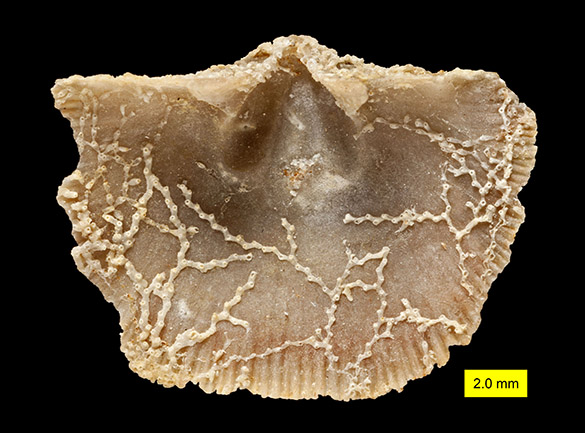 I am very pleased to introduce a new bryozoan genus and species recently described in the First View section of the Journal of Paleontology. Paul Taylor (Natural History Museum, London) and I present: “A new runner-like cyclostome bryozoan from the Bromide Formation (Sandbian, Upper Ordovician) of Oklahoma and its phylogenetic affinities”. The bryozoan is shown above encrusting the interior of an orthid brachiopod identified as Multicostella sulcata (thanks, Alycia Stigall!) in the Lower Echinoderm Zone of the Mountain Lake Member of the Bromide Formation near Fittstown, Oklahoma. We are particularly proud of its new scientific name. Here’s the abstract:
I am very pleased to introduce a new bryozoan genus and species recently described in the First View section of the Journal of Paleontology. Paul Taylor (Natural History Museum, London) and I present: “A new runner-like cyclostome bryozoan from the Bromide Formation (Sandbian, Upper Ordovician) of Oklahoma and its phylogenetic affinities”. The bryozoan is shown above encrusting the interior of an orthid brachiopod identified as Multicostella sulcata (thanks, Alycia Stigall!) in the Lower Echinoderm Zone of the Mountain Lake Member of the Bromide Formation near Fittstown, Oklahoma. We are particularly proud of its new scientific name. Here’s the abstract:
“Zigzagopora wigleyensis n. gen. n. sp. is an Upper Ordovician (Sandbian, early Caradoc) cyclostome bryozoan from the Arbuckle Mountains of Oklahoma, USA. It has runner-type colonies characterized by a mostly uniserial, geniculate arrangement of monomorphic zooids that bud alternately left and right, producing a zig-zag pattern of growth. This new genus has calcified interior walls and non-pseudoporous exterior walls. It is thus most likely affiliated with the paleotubuliporine Family Sagenellidae, despite superficial similarities with the corynotrypid cyclostomes with which it co-occurs.”
You’ve got to love a job where you can coin a name like Zigzagopora wigleyensis. The fortuitous species name, by the way, refers to the Wigley Quarry in Oklahoma (below).
 Here is a pictorial guide to Zigzagopora wigleyensis, featuring Paul’s excellent Scanning Electron Microscope images:
Here is a pictorial guide to Zigzagopora wigleyensis, featuring Paul’s excellent Scanning Electron Microscope images:
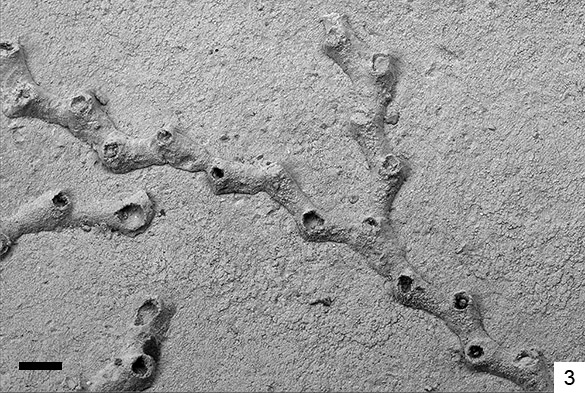 This is what we mean by a “uniserial, geniculate arrangement of monomorphic zooids that bud alternately left and right”. The zooids are the little skeletal tubes, each of which housed an individual bryozoan connected by soft tissue to the rest of the colony. Uniserial means that most series of zooids have just one branching from another. Geniculate means “bent abruptly” like a knee joint. Monomorphic refers to the shape of each zooid being about the same. The scale bar is 0.20 mm.
This is what we mean by a “uniserial, geniculate arrangement of monomorphic zooids that bud alternately left and right”. The zooids are the little skeletal tubes, each of which housed an individual bryozoan connected by soft tissue to the rest of the colony. Uniserial means that most series of zooids have just one branching from another. Geniculate means “bent abruptly” like a knee joint. Monomorphic refers to the shape of each zooid being about the same. The scale bar is 0.20 mm.
It is this zig-zag shape that makes Zigzagopora distinctive. Scale bar is 0.10 mm.
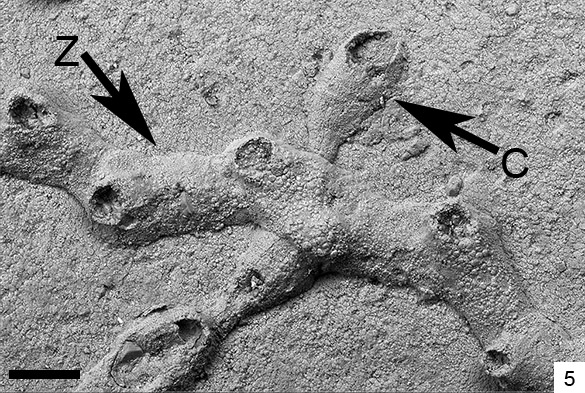 The abstract ends with “… superficial similarities with the corynotrypid cyclostomes with which it co-occurs.” In this scene Zigzagopora (Z) has overgrown a branch of the encrusting cyclostome bryozoan Corynotrypa (C). These bryozoans are obviously similar, but the geniculate (our new word!) nature of Zigzagopora sets it apart. This is significant beyond just the shape of the colony: it indicates a different kind of budding of one zooid from another. The scale bar is 0.20 mm.
The abstract ends with “… superficial similarities with the corynotrypid cyclostomes with which it co-occurs.” In this scene Zigzagopora (Z) has overgrown a branch of the encrusting cyclostome bryozoan Corynotrypa (C). These bryozoans are obviously similar, but the geniculate (our new word!) nature of Zigzagopora sets it apart. This is significant beyond just the shape of the colony: it indicates a different kind of budding of one zooid from another. The scale bar is 0.20 mm.
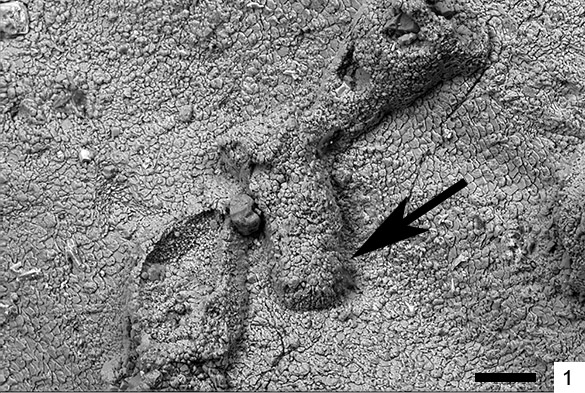 All bryozoans start from an initial zooid called the ancestrula. It is not always easy to find, but is critical for identification and systematics. The arrow points to the protoecium, the first chamber. The scale bar is 0.06 mm.
All bryozoans start from an initial zooid called the ancestrula. It is not always easy to find, but is critical for identification and systematics. The arrow points to the protoecium, the first chamber. The scale bar is 0.06 mm.
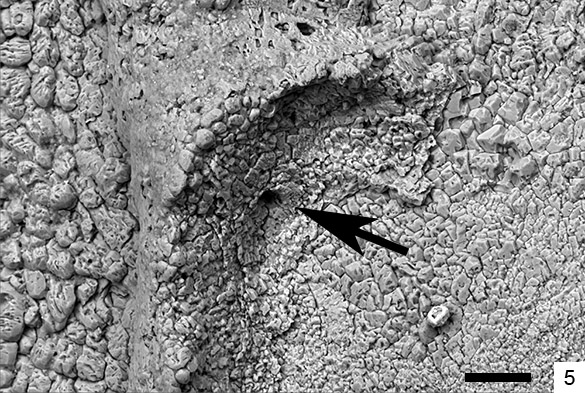 Inside a broken zooid we can see an interior wall surface and a tiny pore. Really tiny. This is likely an interzooidal pore connecting the soft parts of the zooids. Scale bar is 0.03 mm.
Inside a broken zooid we can see an interior wall surface and a tiny pore. Really tiny. This is likely an interzooidal pore connecting the soft parts of the zooids. Scale bar is 0.03 mm.
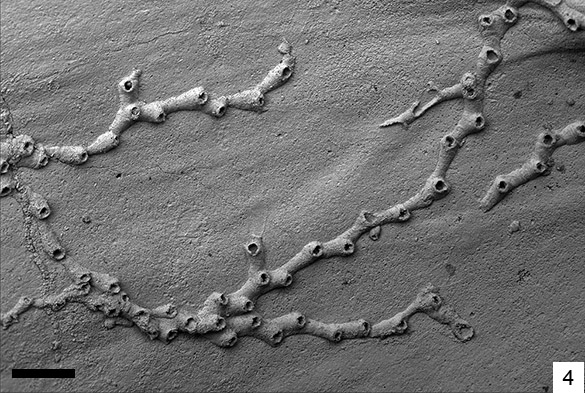 Here, then, is Zigzagopora wigleyensis, new to science. It is a tiny new piece for the puzzle that is the evolution of cyclostome bryozoans. It is one of countless billions of species in the history of life, but unique nonetheless.
Here, then, is Zigzagopora wigleyensis, new to science. It is a tiny new piece for the puzzle that is the evolution of cyclostome bryozoans. It is one of countless billions of species in the history of life, but unique nonetheless.
References:
Taylor, P.D. and Wilson, M.A. 1994. Corynotrypa from the Ordovician of North America: colony form in a primitive stenolaemate bryozoan: Journal of Paleontology 68: 241–257.
Wilson, M.A. and Taylor, P.D. 2016. A new runner-like cyclostome bryozoan from the Bromide Formation (Sandbian, Upper Ordovician) of Oklahoma and its phylogenetic affinities. Journal of Paleontology 90: 413-417.
UPDATE: Zigzagopora wigleyensis made the cover!



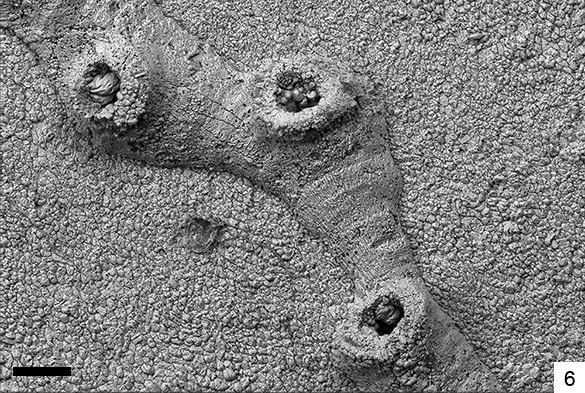
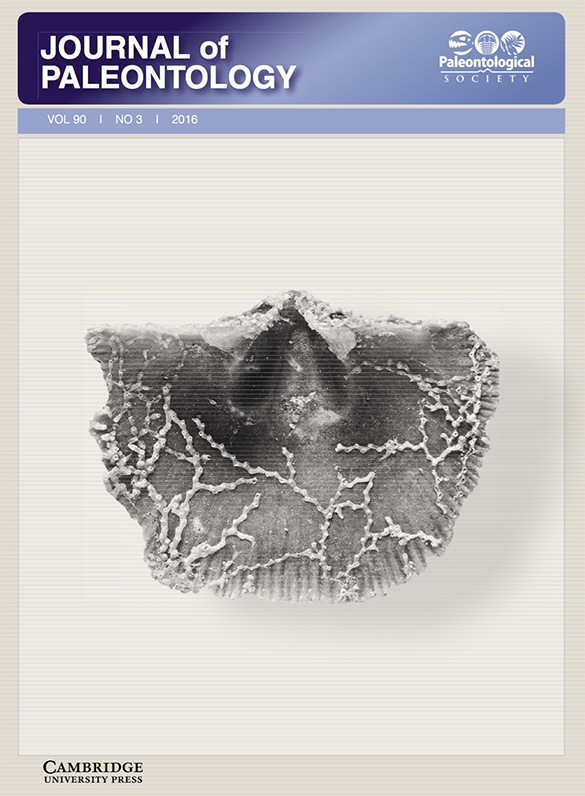
Although this has nothing to do with bryozoans, Mark, this article from BBC Earth can be categorized under the title, “Holy Trace Fossil!”
http://www.bbc.com/earth/story/20160727-extinct-giant-beavers-made-stone-corkscrews-instead-of-dams
Might make a good blog post for you.
Hi Bill. It is an interesting article, but I confine my blog posts to fossils with which we’ve had some interaction. Thanks for the link!